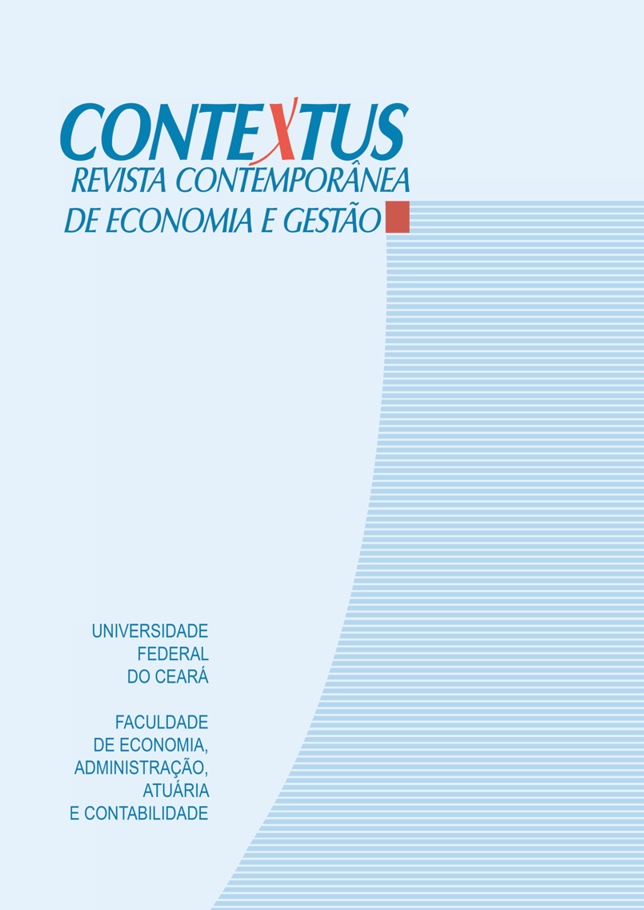Investimento em criptomoedas: Análise pela UTAUT com moderadores culturais
DOI:
https://doi.org/10.19094/contextus.2024.93100Palavras-chave:
criptomoedas, UTAUT, cultura, nível de escolaridade, comportamento do investidor.Resumo
Contextualização: Os ativos de criptomoedas, conhecidos por seu alto risco, têm registrado um aumento significativo no número de usuários, impulsionado pela procura por novas formas de investimento e pela diversificação de portfólios. Esta pesquisa se propõe a explorar e avaliar os fatores que determinam a intenção e o comportamento de investimento em criptomoedas.
Objetivo: O objetivo principal do estudo é compreender os efeitos da intenção de investir em criptos usando uma teoria de comportamento, acrescentando ao modelo a moderação cultural no comportamento de investimento em criptomoedas.
Método: Pesquisa quantitativa que utiliza a Teoria Unificada da Aceitação e Uso da Tecnologia (UTAUT) como lente teórica, a pesquisa aplicou um questionário on-line e obteve 222 respostas válidas para análise, dados coletados de fevereiro a maio de 2021. A análise de dados partiu da modelagem de equações estruturais, com estimação pelo método partial least squares.
Resultados: Os resultados revelaram a contribuição que a UTAUT tem na intenção de investir em criptomoedas, e que as variáveis de expectativa de performance, influência social e condições facilitadoras afetam a intenção de se investir em criptos.
Conclusões: O nível de escolaridade, na amostra representada de maioria investidores propensos ao risco, foi fator significativo e moderador das variações no resultado do uso da UTAUT no contexto do comportamento de investidores em criptomoedas.
Referências
Abramova, S., & Böhme, R. (2016). Perceived benefit and risk as multidimensional determinants of bitcoin use: a quantitative exploratory study. International Conference on Information Systems, Dublin, Republic of Ireland, 37. https://informationsecurity.uibk.ac.at/pdfs/Abramova2016_Bitcoin_ICIS.pdf
Agustina, D. (2019). Extension of Technology Acceptance Model (ETAM): Adoption of Cryptocurrency Online Trading Technology. Jurnal Ekonomi, 24(2), 272-287. https://doi.org/10.24912/je.v24i2.591
Alkashri, Z., Alqaryouti, O., Siyam, N., & Shaalan, K. (2020). Mining Dubai government tweets to analyze citizens’ engagement. Recent advances in intelligent systems and smart applications (pp. 615-638). Cham: Springer International Publishing. https://link.springer.com/chapter/10.1007/978-3-030-47411-9_33
Baptista, G., & Oliveira, T. (2015). Understanding mobile banking: The unified theory of acceptance and use of technology combined with cultural moderators. Computers in Human Behavior, 50, 418-430. https://doi.org/10.1016/j.chb.2015.04.024
Bauer, R. A. (1960). Consumer behavior as risk taking. Proceedings of the 43rd National Conference of the American Marketing Association, Chicago, Illinois, 43. https://cir.nii.ac.jp/crid/1572543025452826496
Borri, N. (2019). Conditional tail-risk in cryptocurrency markets. Journal of Empirical Finance, 50, 1-19. https://doi.org/10.1016/j.jempfin.2018.11.002
Bunjaku, F., Gjorgieva-Trajkovska, O., & Miteva-Kacarski, E. (2017). Cryptocurrencies – Advantages and Disadvantages. Journal of Economics, 2(1), 31-39. https://js.ugd.edu.mk/index.php/JE/article/view/1933
Chin, W. W. (1998). The partial least squares approach for structural equation modeling. In G. A. Marcoulides (Ed.), Modern methods for business research (pp. 295–336). Lawrence Erlbaum Associates Publishers.
CoinMarketCap. (2024). CoinMarketCap. https://coinmarketcap.com/
Conlon, T., Corbet, S., & McGee, R. J. (2020). Are cryptocurrencies a safe haven for equity markets? An international perspective from the COVID-19 pandemic. Research in International Business and Finance, 54, 101248. https://doras.dcu.ie/25978/1/R19.pdf
Corbet, S., Meegan, A., Larkin, C., Lucey, B., & Yarovaya, L. (2018). Exploring the dynamic relationships between cryptocurrencies and other financial assets. Economics Letters, 165, 28-34. https://doi.org/10.1016/j.econlet.2018.01.004
Davis, F. D. (1986). A technology acceptance model for empirically testing new end-user information systems. Cambridge, MA, 17.
Davis, F. D. (1989). Perceived usefulness, perceived ease of use, and user acceptance of information technology. MIS Quarterly, 319-340. https://doi.org/10.2307/249008
Donatelli, O., Neto & Colombo, J. A. (2021). The Impact of Cryptocurrencies on the Performance of Multi-Asset Portfolios: Analysis from the Perspective of a Brazilian Investor. FGV EESP - Working Paper Series. https://hdl.handle.net/10438/30900
Fishbein, M., & Ajzen, I. (1975), Belief, Attitude, Intention, and Behavior: An Introduction to Theory and Research. Read-ing, MA: Addison-Wesley.
Fishbein, M., & Ajzen, I. (1980). Understanding attitudes and predicting social behavior. Prentice-Hall.
Folkinshteyn, D., & Lennon, M. (2016). Braving Bitcoin: A technology acceptance model (TAM) analysis. Journal of Information Technology Case and Application Research, 18(4), 220-249. https://doi.org/10.1080/15228053.2016.1275242
Fornell, C., & Larcker, D. F. (1981). Evaluating structural equation models with unobservable variables and measurement error. Journal of Marketing Research, 18(1), 39-50. https://doi.org/10.1177/002224378101800104
Gil-Alana, L. A., Abakah, E. J. A., & Rojo, M. F. R. (2020). Cryptocurrencies and stock market indices. Are they related? Research in International Business and Finance, 51, 101063. https://doi.org/10.1016/j.ribaf.2019.101063
Hair, J. F., Risher, J. J., Sarstedt, M., & Ringle, C. M. (2019). When to use and how to report the results of PLS-SEM. European Business Review, 31(1), 2-24. https://doi.org/10.1108/EBR-11-2018-0203
Hofstede, G. (1980). Culture's consequences: International differences in work-related values. Beverly Hills/London: Sage.
Hofstede, G. (2001). Culture's consequences: Comparing values, behaviors, institutions and organizations across nations. Sage publications.
Hofstede, G. (2003). Cultural Dimensions. www.geert-hofstede.com
Hofstede, G., Garibaldi de Hilal, A. V., Malvezzi, S., Tanure, B., & Vinken, H. (2010). Comparing regional cultures within a country: Lessons from Brazil. Journal of Cross-Cultural Psychology, 41(3), 336-352. https://journals.sagepub.com/doi/10.1177/0022022109359696
Iqbal, N., Fareed, Z., Guangcai, W., & Shahzad, F. (2020). Asymmetric nexus between COVID-19 outbreak in the world and cryptocurrency market. International Review of Financial Analysis, 73, 101613. https://doi.org/10.1016/j.irfa.2020.101613
Jung, K. J., Park, J. B., Phan, N. Q., Bo, C., & Gim, G. Y. (2018, June). An international comparative study on the intension to using crypto-currency. International Conference on Applied Computing and Information Technology (pp. 104-123). Springer, Cham. https://doi.org/10.1007/978-3-319-98370-7_9
Khan, I. U., Hameed, Z., & Khan, S. U. (2017). Understanding online banking adoption in a developing country: UTAUT2 with cultural moderators. Journal of Global Information Management (JGIM), 25(1), 43-65. https://doi.org/10.4018/JGIM.2017010103
Kwateng, K. O., Atiemo, K. A. O., & Appiah, C. (2019). Acceptance and use of mobile banking: an application of UTAUT2. Journal of Enterprise Information Management, 32(1), 118-151. https://doi.org/10.1108/JEIM-03-2018-0055
Lahmiri, S., & Bekiros, S. (2020). The impact of COVID-19 pandemic upon stability and sequential irregularity of equity and cryptocurrency markets. Chaos, Solitons & Fractals, 138, 109936.
Makarov, I., & Schoar, A. (2020). Trading and arbitrage in cryptocurrency markets. Journal of Financial Economics, 135(2), 293-319. https://doi.org/10.1016/j.jfineco.2019.07.001
Malhotra, N. K., & McCort, J. D. (2001). A cross‐cultural comparison of behavioral intention models‐Theoretical consideration and an empirical investigation. International Marketing Review. 18(3), 18-40 https://doi.org/10.1509/jimk.18.3.18
Möser, M., Böhme, R., & Breuker, D. (2014). Towards risk scoring of Bitcoin transactions. International Conference on Financial Cryptography and Data Security (pp. 16-32). Springer, Berlin, Heidelberg. https://maltemoeser.de/paper/risk-scoring.pdf
Mutambara, E. (2019). Predicting FinTech innovation adoption in South Africa: the case of cryptocurrency. African Journal of Economic and Management Studies, 11(1), 30-50. https://doi.org/10.1108/AJEMS-04-2019-0152
Nseke, P. (2018). How crypto-currency can decrypt the global digital divide: bitcoins a means for African emergence. International Journal of Innovation and Economic Development, 3(6), 61-70. https://doi.org/10.18775/ijied.1849-7551-7020.2015.36.2005
Park, S., & Park, H. W. (2020). Diffusion of cryptocurrencies: web traffic and social network attributes as indicators of cryptocurrency performance. Quality & Quantity, 54(1), 297-314. https://doi.org/10.1007/s11135-019-00840-6
Rognone, L., Hyde, S., & Zhang, S. S. (2020). News sentiment in the cryptocurrency market: An empirical comparison with Forex. International Review of Financial Analysis, 69, 101462. https://doi.org/10.1016/j.irfa.2020.101462
Sahoo, P. K. (2021). COVID-19 pandemic and cryptocurrency markets: an empirical analysis from a linear and nonlinear causal relationship. Studies in Economics and Finance, 38(2), 454-468. https://doi.org/10.1108/SEF-09-2020-0385
Shahzad, F., Xiu, G., Wang, J., & Shahbaz, M. (2018). An empirical investigation on the adoption of cryptocurrencies among the people of mainland China. Technology in Society, 55, 33-40. https://doi.org/10.1016/j.techsoc.2018.05.006
Shen, W. (2021). New development on regulation of cryptocurrency in China. Journal of Investment Compliance, 22(2), 133-136. https://doi.org/10.1108/JOIC-11-2020-0045
Venkatesh, V., & Davis, F. D. (1996). A model of the antecedents of perceived ease of use: Development and test. Decision Sciences, 27(3), 451-481. https://doi.org/10.1111/j.1540-5915.1996.tb00860.x
Venkatesh, V., & Davis, F. D. (2000). A theoretical extension of the technology acceptance model: Four longitudinal field studies. Management Science, 46(2), 186-204. https://doi.org/10.1287/mnsc.46.2.186.11926
Venkatesh, V., Morris, M. G., Davis, G. B., & Davis, F. D. (2003). User Acceptance of information technology: Toward a unified view. Management Information Systems Quarterly, 27(3), 425-478. https://doi.org/10.2307/30036540
Venkatesh, V., Thong, J. Y., & Xu, X. (2012). Consumer acceptance and use of information technology: extending the unified theory of acceptance and use of technology. MIS Quarterly, 157-178. https://doi.org/10.2307/41410412
Walton, A., & Johnston, K. (2018). Exploring perceptions of bitcoin adoption: The South African virtual community Perspective. Interdisciplinary Journal of Information, Knowledge & Management, 13, 165-182. https://doi.org/10.28945/4080
Williams, M. D., Rana, N. P., & Dwivedi, Y. K. (2015). The unified theory of acceptance and use of technology (UTAUT): a literature review. Journal of Enterprise Information Management, 28(3), 443-488. https://doi.org/10.1108/JEIM-09-2014-0088
Yoshinaga, C., & Rocco, F. (2020). Atenção do Investidor: O Volume de Buscas no Google é Capaz de Prever os Retornos de Ações?. BBR. Brazilian Business Review, 17, 523-539. https://doi.org/10.15728/bbr.2020.17.5.3
Yu, C. S. (2012). Factors affecting individuals to adopt mobile banking: Empirical evidence from the UTAUT model. Journal of Electronic Commerce Research, 13(2), 104. http://www.jecr.org/sites/default/files/13_3_p01_0.pdf
Publicado
Como Citar
Edição
Seção
Licença
Copyright (c) 2024 Revista: apenas para a 1a. publicação

Este trabalho está licenciado sob uma licença Creative Commons Attribution-NonCommercial 4.0 International License.
Os autores, no ato da submissão, aceitam a declaração abaixo:
Nós autores mantemos sobre nosso artigo publicado os direitos autorais e concedemos à revista Contextus o direito de primeira publicação, com uma licença Creative Commons na modalidade Atribuição – Não Comercial 4.0 Internacional, a qual permite o compartilhamento com reconhecimento da autoria e da publicação inicial nesta revista.
Temos ciência de estarmos autorizados a assumir contratos adicionais separadamente, para distribuição não exclusiva da versão do trabalho publicada nesta revista (ex.: publicar em repositório institucional ou como capítulo de livro), também com reconhecimento tanto da autoria, quanto da publicação inicial neste periódico.
Atestamos que o artigo é original ou inédito, não foi publicado, até esta data, em nenhum periódico brasileiro ou estrangeiro, quer em português, quer em versão em outra língua, nem está encaminhado para publicação simultânea em outras revistas.
Sabemos que o plágio não é tolerado pela revista Contextus e asseguramos que o artigo apresenta as fontes de trechos de obras citadas, incluindo os de qualquer trabalho prévio produzido e publicado pelos próprios autores.









3.png)


1.jpg)



1.jpg)


1.jpg)






.jpg)



1.jpg)

1.jpg)


1.jpg)

1.jpg)
1.jpg)
2.png)




1.jpg)
2.jpg)

1.jpg)





1.jpg)


1.jpg)
1.jpg)
